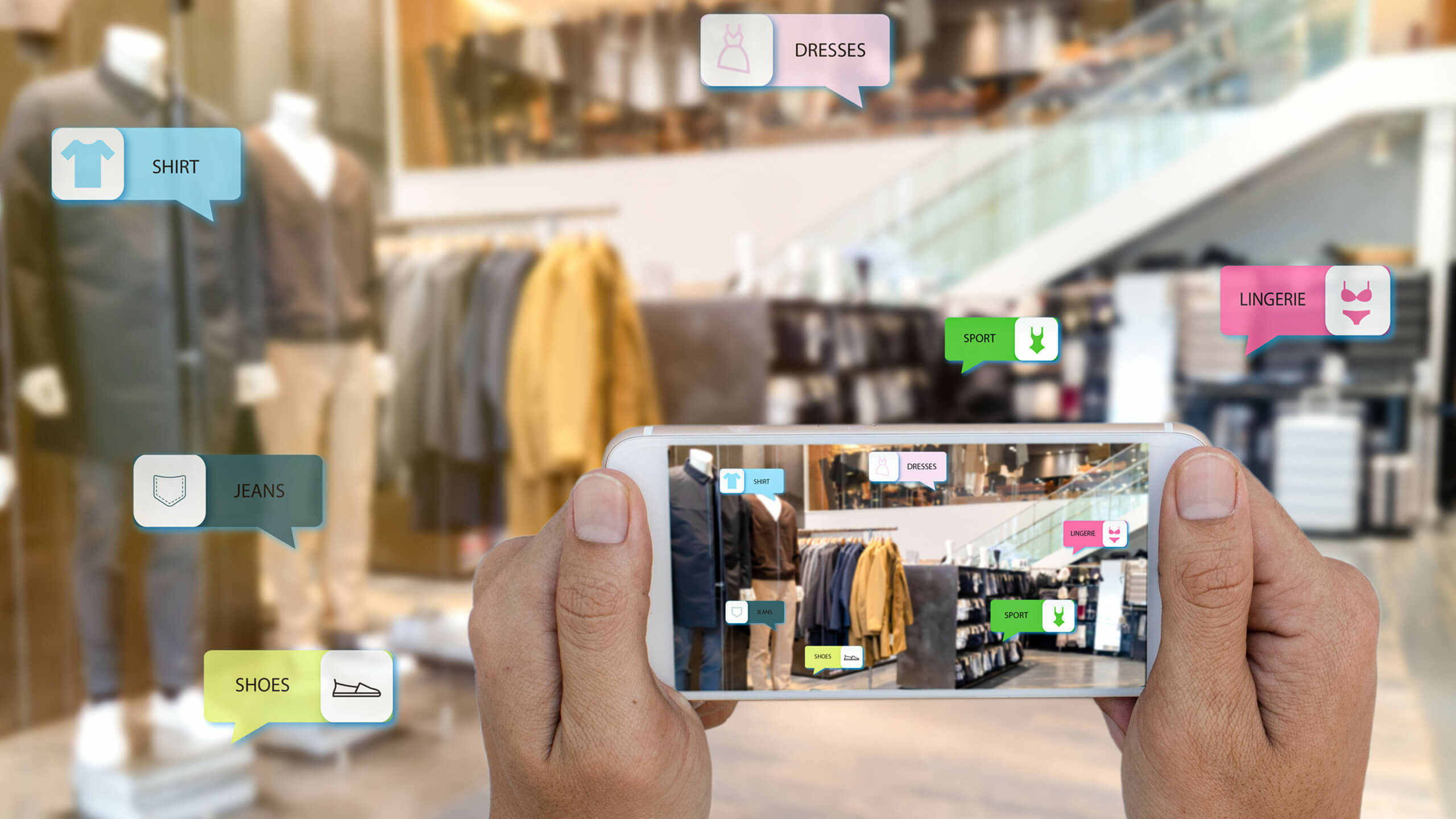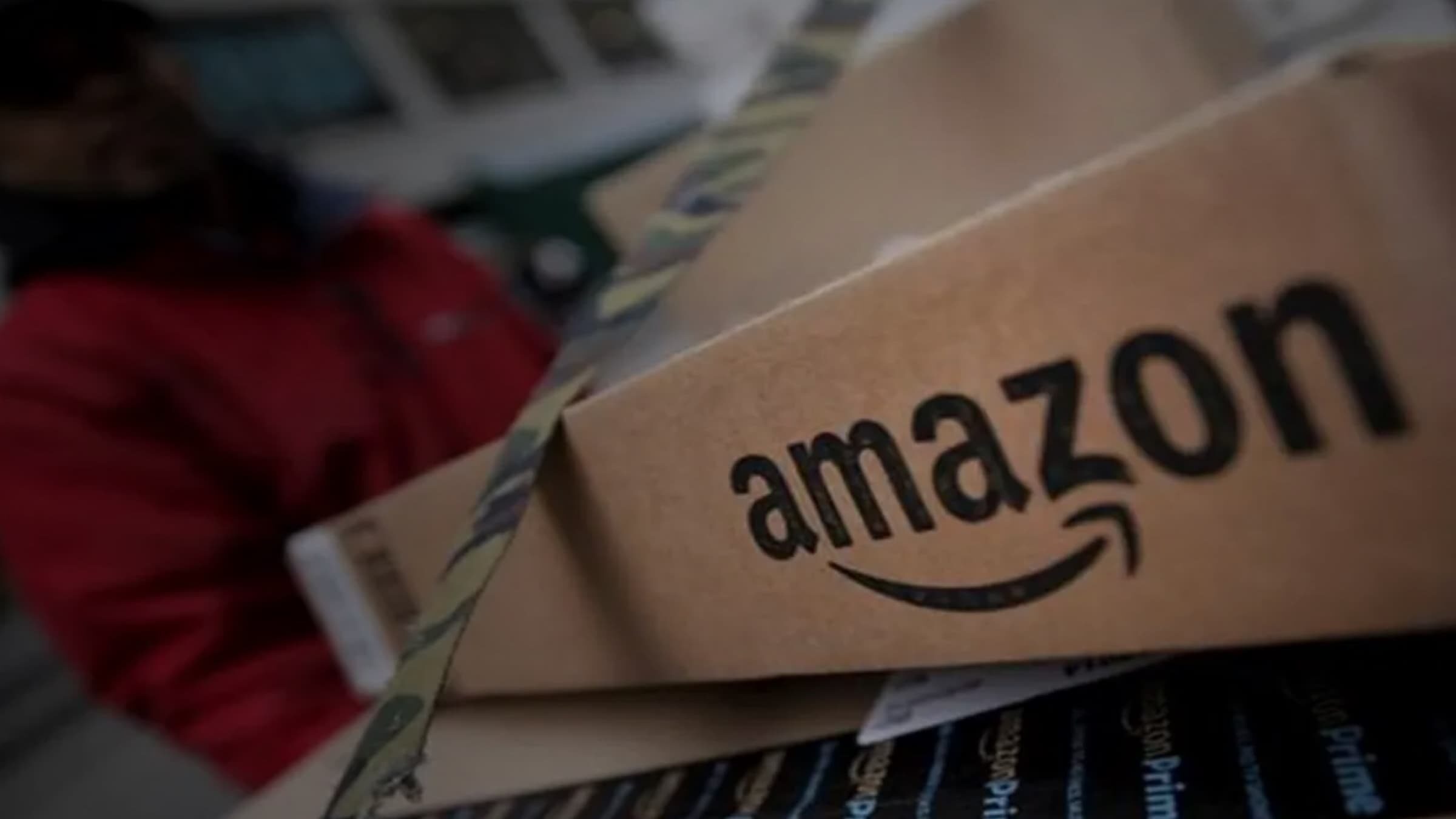When it comes to classifying and analyzing images, humans can easily recognize distinct features of objects and associate them with individual definitions. However, visual recognition is a highly complex task for machines because it involves identifying multiple objects and finding object relationships. Image recognition has been a long-standing research problem in the computer vision field. But, the recent development in AI has improved the process of object detection, image identification, and image classification. The image recognition market is assumed to rise globally to a market size of $42.2 billion by 2022. Various industries are adopting image recognition technology to improve augmented reality applications, optimize medical imagery, boost driverless car technology, predict consumer behavior, and much more.
Although image recognition is a relatively new aspect of analysis, it is also making its way into eCommerce. Image recognition is helping retailers to expand consumer reach, offer insights into trends, and improve customers’ online shopping experience for the eCommerce industry. The Global Image Recognition in Retail Market is estimated to be USD 1.8 Bn in 2021 and is expected to reach USD 4.5 Bn by 2026, growing at a CAGR of 20%.
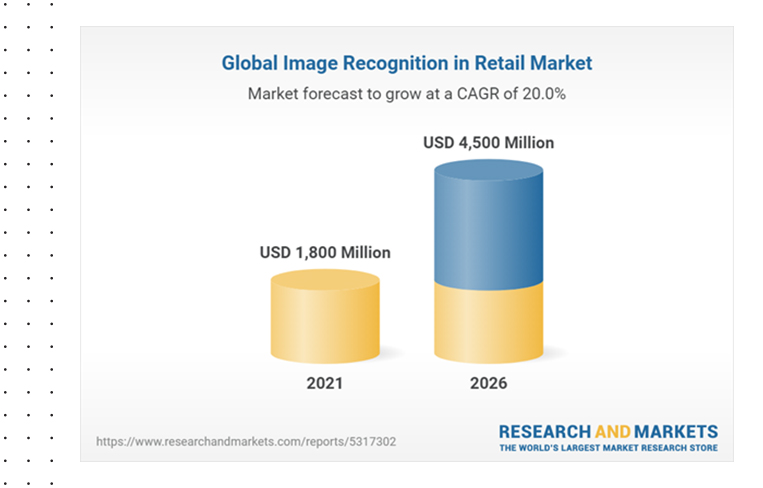
In this blog, you’ll learn about image recognition technology and its importance in the retail industry.
What is Image Recognition?
Image recognition, a subcategory of computer vision, is a technology that can identify objects, entities, or attributes in digital images or videos. However, computer vision is a broader term, including methods for gathering, processing, and analyzing data from the real world. Image recognition can be performed at varying degrees of accuracy, depending on the type of information required.
Image recognition can perform the following tasks:

- Classification: It identifies the “class,” i.e., the category to which an image belongs. A picture can have only one class.
- Tagging: It’s a classification task but involves a higher degree of accuracy. Tagging can recognize several concepts or objects within an image, and there can be more than one tag assigned to a particular image.
- Detection and localization: This step helps locate object(s) in an image. Once the system locates the object in question, localization helps to place a bounding box around it.
- Segmentation: This is also a detection task but involves a higher degree of precision. Segmentation locates element(s) to the nearest pixel in an image.
- Instance segmentation: It helps differentiate multiple objects belonging to the same class.
Image Recognition in eCommerce and how it works
Nowadays, increasing competition and customer expectations are forcing online retailers to constantly monitor market dynamics wrt their pricing, promotion & product assortment in order to stay competitive. To get these insights, retailers need to match and compare their products against their competitors to see where the gaps are. That’s where product matching comes in.
Product matching refers to finding the same or similar products against a target universe of products from across the web, across multiple competing retailers. Product matching uses AI-based image recognition to determine product attributes, find patterns, and detect text, product price, shipping information, and so on.
Here’s how DataWeave’s AI-powered analytics platform uses image recognition & aggregates insights & data for retailers from across the web to provide a comprehensive view of the online competitive environment.
Image recognition use-cases in the retail industry
a. Attribute tagging
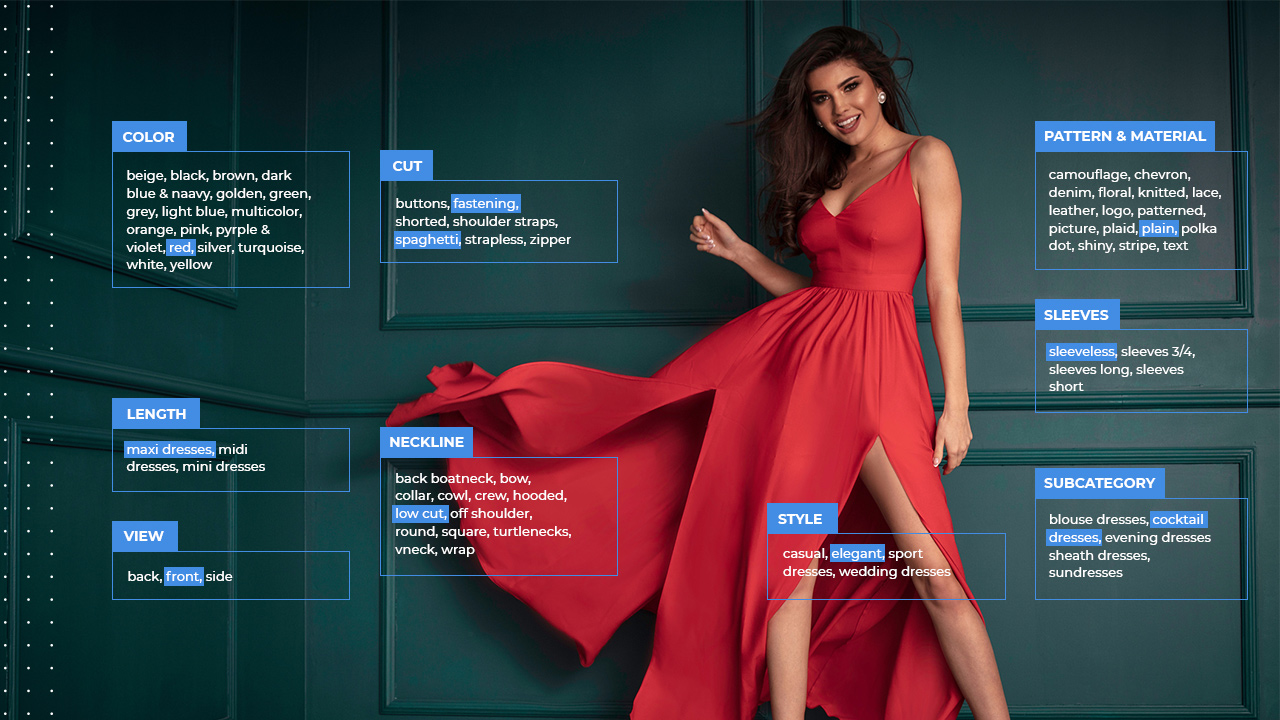
Getting shoppers to your eCommerce platform is one thing and getting them to complete a purchase is a steeper hill to climb. If your platform can’t provide search results that match with customers’ requirements, they’ll get lost, grow frustrated, and drop off. Attribute tagging with image recognition allows eCommerce stores to automatically generate attributes for all products so customers can quickly find products they are looking for.
Tags allow users to filter products based on the categories they want to explore. Product tags include everything the customer might specifically search for — color, type, size, brand, use, design, fabric, discount, etc. For example, a dress could have tags like red, evening, midi, summer, long-sleeve, silk, summer sale, etc. When a user looks for midi dresses or long-sleeve dresses, products with these tags will show up.
b. Search by image

Visual Search allows users to look for similar products using a reference image from their camera roll or downloaded from the internet. The visual search feature also enables eCommerce businesses to implement image-based search into their software applications. It maximizes the searchable potential of their visual data.
Meanwhile, Gartner predicts a 30% increase in digital commerce revenue by 2021 for companies who start supporting visual and voice search on their websites and apps. The benefits of visual search include more personalized, easy product recommendations and enhanced product discovery.
c. Fashion trend analysis
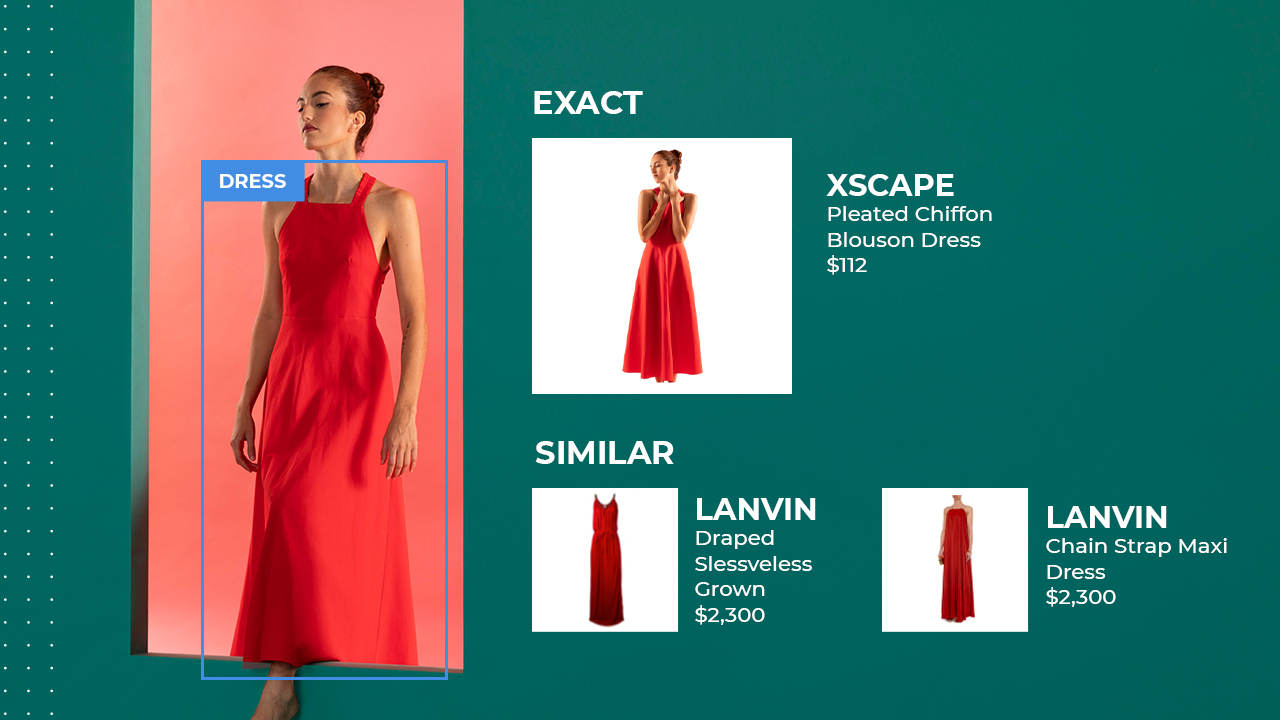
Tapping into trending product categories is a goldmine for any eCommerce business. Having insights into trending categories and products means less competition on search engines, fewer ads, and intelligent pricing. All of which can boost any retailer’s margins. Image recognition technology provides information about colors, styling techniques, fabric textures, prints, and more to spark consumer demand. It works by scanning social media images to pinpoint trending attributes and predict fashion trends. For instance, while scanning images, technology understands that it’s seeing a photo of a color-blocked sweatshirt because it recognizes the product has a hooded neck, full sleeves, blocks of different colors, and even the type of fabric. This technology can analyze millions of images, helping retailers analyze the volume of color-blocked sweatshirts.
We do this seamlessly at DataWeave. Our similarity matching solution helps retailers gather insights into attributes for products similar to the ones they’re carrying on their site. Similarity matching helps retailers gain visibility into their entire competitive landscape to keep their e-commerce strategy responsive to price & product assortment shifts among consumers and rivals
d. Augmented reality
According to Statista, the AR market is valued at $9.5 billion, with around 810 million active mobile users. Since shoppers want the full sensory product experience before shopping online, augmented reality (AR) can help them understand what they’re buying and how the product will work for them. There are AR applications for trying makeup, clothing, accessories, and even eyeglasses. IKEA was one of the pioneers in using AR for eCommerce retail. In 2017, IKEA launched the Place app, allowing shoppers to see how thousands of items will look in their homes, with 98% accuracy.
Image recognition helps AR applications anchor virtual content with the real world. For instance, Sephora has a Virtual Artist that allows users to try different makeup looks and even take pictures of an outfit they’re planning to wear to match the shade. Users can even check out full-face looks and learn how to do their makeup with virtual tutorials.
e. Counterfeit Detection

Another application of image recognition that has proven to be very successful is counterfeit product detection. It has become increasingly difficult for brands and retailers to find and eliminate fake items on eCommerce sites. U.S. Customs seized over 13,500 counterfeit goods worth $30 Million in November 2021, indicating how brands and online marketplaces have struggled in the past to find an effective solution.
Essentially, image recognition technology allows eCommerce sites to detect products with fake logos and designs attempting to sell as legitimate brands by capturing discrepancies in images and content. The system flags and delists the products and sellers when a fake is detected.
Here’s how DataWeave helped Classic Accessories, a leading manufacturer of high-quality covers, furnishings, and accessories automate their counterfeit detection process using our super Image Recognition capabilities.
f. User-generated content analysis
Visual content plays a vital role in eCommerce sites, especially when it comes to product photos and videos. Today, branded visual content isn’t as effective as it’s one-dimensional. As a matter of fact, 93% of marketers agree that customers trust user-generated content more than content produced by brands. However, user-generated content that features product images or videos is way more exciting, realistic, and creative. It gives customers an appealing view of products being used in real life.
The most common form of UGC, i.e., reviews and ratings, have been the key for eCommerce brands as they are quantitative and qualitative metrics about a product/service quality, worth, value, reliability, etc. With image recognition, retailers can access insights into strengths and gaps in all product offerings by understanding what consumers are saying about them.
Here’s how DataWeave can help retailers and brands analyze consumer reviews & help them adapt to customer needs.
Conclusion
Because of its massive influence, image recognition technology is becoming widely adopted by eCommerce companies. It benefits both retailers and customers. Image recognition based on deep learning can provide retailers with helpful capacities like customer analytics, counterfeit detection, personalized searches, and more. Retailers can also use the data gathered from image recognition eCommerce technology to design effective marketing campaigns and improve their ROI.
With super sharp image recognition capabilities, DataWeave offers 90% accuracy in matching eCommerce products, allowing us to provide comprehensive and precise insights into pricing and assortments. Sign up for a demo with our team to know more.
Book a Demo
Login
For accounts configured with Google ID, use Google login on top.
For accounts using SSO Services, use the button marked "Single Sign-on".
